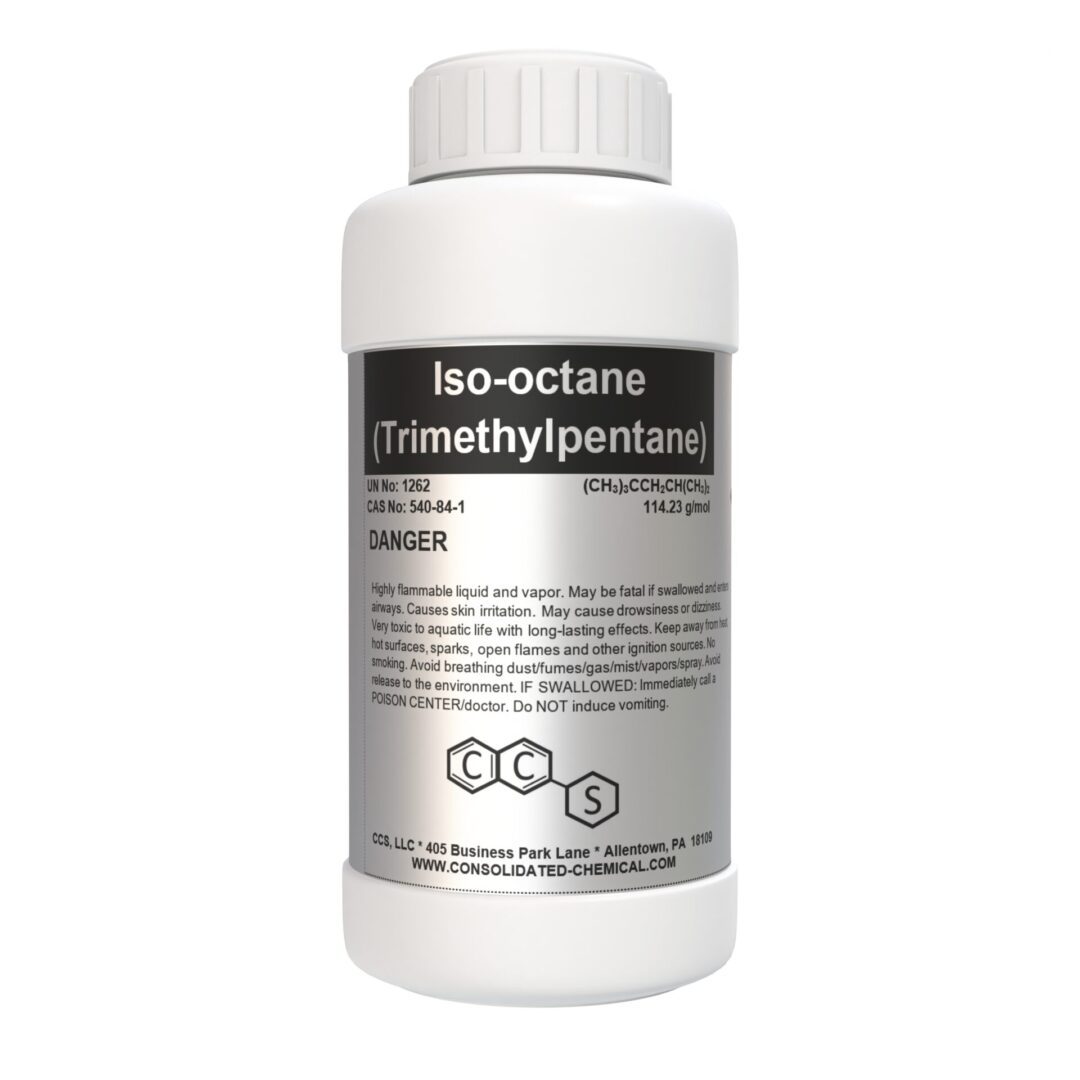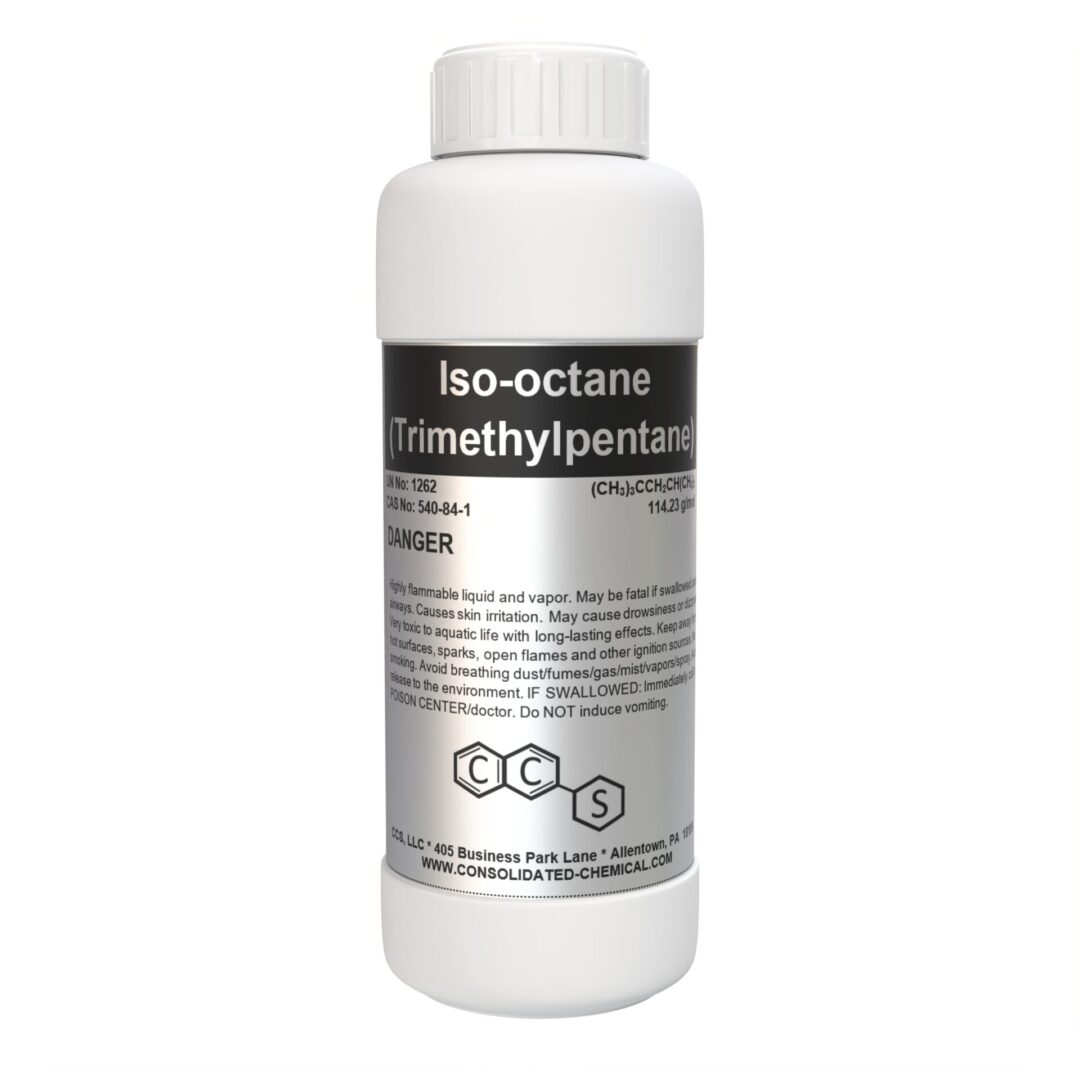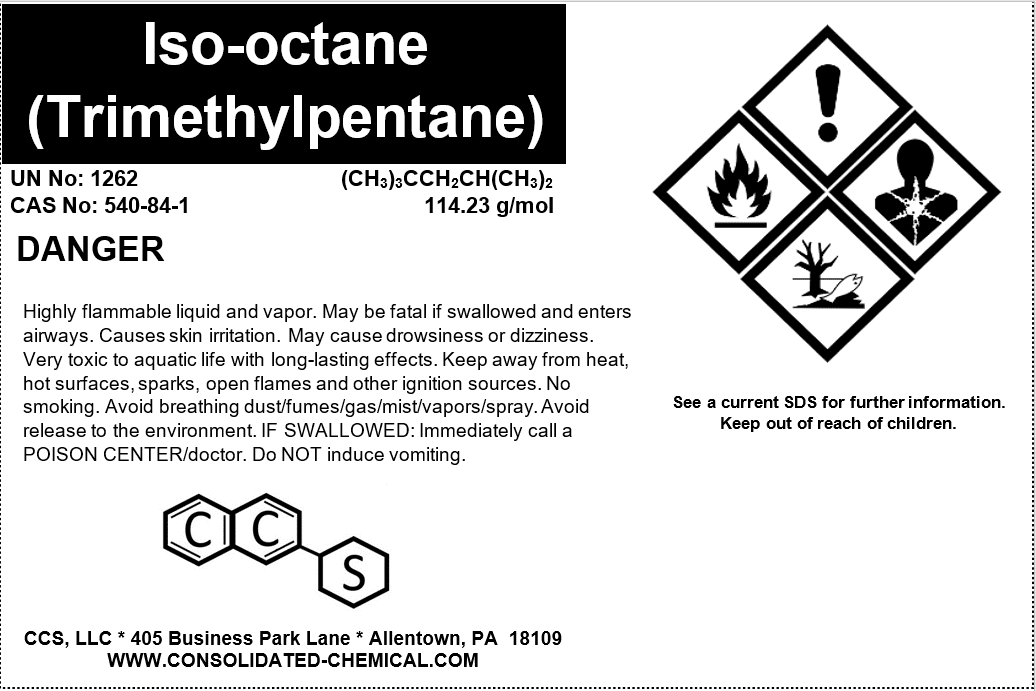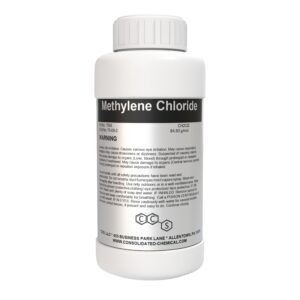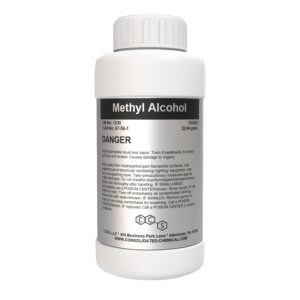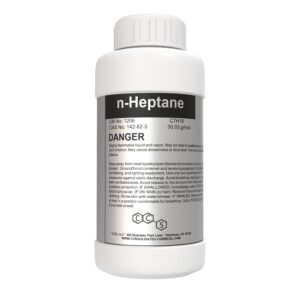Isooctane (2,2,4-Trimethylpentane) – ACS Grade Hydrocarbon
$14.99 – $45.00
Chemical Identity
- Chemical Name: Isooctane
- IUPAC Name: 2,2,4-Trimethylpentane
- Molecular Formula: C₈H₁₈
- Molecular Weight: 114.23 g/mol
- CAS Number: 540-84-1
- EINECS Number: 208-759-1
Physical Properties
- Appearance: Clear, colorless liquid
- Odor: Mild hydrocarbon-like scent
- Boiling Point: ~99°C (~210°F)
- Melting Point: -107°C (-161°F)
- Flash Point: -12°C (~10°F), Closed Cup
- Density: ~0.692 g/cm³ at 20°C
- Refractive Index: 1.391–1.392 at 20°C
- Vapor Pressure: ~49 mmHg at 25°C
- Auto-ignition Temperature: ~415°C (~779°F)
- Solubility: Insoluble in water; highly soluble in organic solvents
Chemical Properties
- Purity: ≥ 99% (Industrial and Analytical Grades Available)
- Stability: Stable under normal conditions, flammable in vapor form
- Chemical Family: Alkane (Branched hydrocarbon)
Description
Isooctane, also known as 2,2,4-Trimethylpentane, is a high-purity hydrocarbon commonly used as a standard reference fuel and in various industrial applications. It is known for its role in determining the octane rating of gasoline due to its excellent anti-knock properties.
Applications of Isooctane (Trimethylpentane)
Fuel Industry
- Octane Rating Reference: Isooctane is the standard reference compound for determining the octane rating of fuels.
- High-Performance Fuels: Used in aviation and race car fuels for its superior anti-knock properties.
- Fuel Additive: Enhances fuel stability and performance in internal combustion engines.
Solvent
- Non-Polar Solvent: Used as a solvent in organic chemical reactions and extractions.
- Laboratory Applications: Frequently employed in chromatography and other analytical techniques.
Industrial Applications
- Adhesives and Coatings: Utilized in the formulation of industrial adhesives, varnishes, and paints due to its solvency.
- Lubricants: Acts as a diluent or carrier in lubricant production.
- Petrochemical Feedstock: Serves as a precursor for synthesizing other chemical intermediates.
Testing and Research
- Engine Testing: A key component in engine performance testing and calibration of fuel blends.
- Standard Calibration: Used in laboratories as a high-purity reference material for analytical testing.
Cleaning and Degreasing
- Industrial Cleaners: Isooctane’s ability to dissolve oils and greases makes it ideal for cleaning machinery and components.
- Electronics Manufacturing: Used in cleaning processes for electronic parts and circuits.
Specialty Applications
- Pharmaceuticals: Occasionally used as a solvent or intermediate in drug manufacturing.
- Aerospace Industry: Contributes to the production of high-performance materials and fuels.
- Cosmetics: Can be used as a carrier solvent in certain cosmetic formulations.
Storage Guidelines
- Temperature:
- Store at ambient temperatures in a cool, dry place.
- Avoid exposure to heat sources or direct sunlight.
- Containers:
- Use tightly sealed, corrosion-resistant containers such as steel or HDPE drums.
- Ensure containers are clearly labeled.
- Environment:
- Keep in a well-ventilated area to prevent vapor accumulation.
- Store away from incompatible materials like oxidizing agents, acids, or bases.
- Fire Safety:
- Isooctane is highly flammable. Store away from ignition sources, open flames, and static electricity.
- Utilize explosion-proof equipment in storage areas.
- Spill Containment:
- Ensure the storage area has secondary containment measures (e.g., spill trays) to prevent leaks or spills from spreading.
Handling Guidelines
- Personal Protective Equipment (PPE):
- Wear appropriate PPE, including:
- Chemical-resistant gloves (e.g., nitrile or neoprene)
- Safety goggles or face shield
- Flame-resistant clothing
- Respiratory protection in areas with insufficient ventilation
- Wear appropriate PPE, including:
- Work Area:
- Handle in a well-ventilated space or under a fume hood to avoid inhaling vapors.
- Use non-sparking tools and explosion-proof equipment.
- Precautions:
- Avoid contact with skin, eyes, or clothing.
- Do not eat, drink, or smoke while handling the product.
- Ground and bond containers during transfers to prevent static discharge.
- First Aid Measures:
- Inhalation: Move to fresh air immediately and seek medical attention if symptoms persist.
- Skin Contact: Wash thoroughly with soap and water. Remove contaminated clothing.
- Eye Contact: Rinse eyes with water for at least 15 minutes. Seek medical attention if irritation occurs.
- Ingestion: Do not induce vomiting. Rinse mouth and seek immediate medical attention.
Additional information
| Size | 100mL (3.3 Fl Oz), 250mL (8 Fl Oz), 500mL (16 Fl Oz), 1000mL (32 Fl Oz) |
|---|
Related products
-

Methylene Chloride (Dichloromethane)
$28.00 – $135.00 Select options This product has multiple variants. The options may be chosen on the product page -

Methyl Isoeugenol – High-Quality Aroma and Flavor Ingredient
$12.00 Add to cart -

Methyl Alcohol (Methanol) – Premium Multi-Purpose Solvent
$12.99 – $70.00 Select options This product has multiple variants. The options may be chosen on the product page -

N-Heptane – High Purity Bestine Thinner
$14.00 – $67.00 Select options This product has multiple variants. The options may be chosen on the product page
SKU: N/A
Categories: Fuel Additive, Industrial Chemical, Solvents (3)
Tags: 2, 4-Trimethylpentane, buy isooctane online, CAS 540-84-1, high-performance isooctane, high-purity isooctane, industrial-grade isooctane supply, Isooctane, isooctane automotive fuels, isooctane bulk purchase, isooctane bulk supplier, isooctane calibration standard, isooctane chemical applications, isooctane chemical intermediate, Isooctane chemical supplier, isooctane distributor, isooctane flammable compound, isooctane flammable liquid, isooctane for adhesives, isooctane for aviation fuels, isooctane for chromatography, isooctane for coatings, isooctane for degreasing, isooctane for engine testing, isooctane for fuel blending, isooctane for high-performance fuels, isooctane for octane rating, isooctane for petrochemical processes, Isooctane fuel additive, isooctane fuel performance enhancer, isooctane fuel testing chemical, isooctane high-octane compound, isooctane hydrocarbon, isooctane hydrocarbon liquid, isooctane in engine calibration, isooctane in fuel research, isooctane in lubricant formulations, isooctane industrial solvent, isooctane industrial use, isooctane industrial-grade, isooctane laboratory solvent, isooctane manufacturer, isooctane non-polar solvent, isooctane octane booster, isooctane organic solvent, isooctane petrochemical feedstock, Isooctane solvent, isooctane storage guidelines, isooctane supplier, isooctane wholesale, pure isooctane for sale, reference fuel compound

